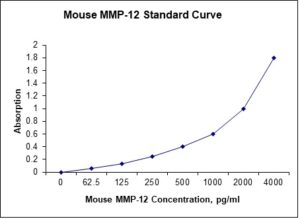Nori Mouse MMP12 ELISA Kit
$461.00 – $832.00
This ELISA kit is for quantification of MMP12 in mouse. This is a quick ELISA assay that reduces time to 50% compared to the conventional method, and the entire assay only takes 3 hours. This assay employs the quantitative sandwich enzyme immunoassay technique and uses biotin-streptavidin chemistry to improve the performance of the assays. An antibody specific for MMP12 has been pre-coated onto a microplate. Standards and samples are pipetted into the wells and any MMP12 present is bound by the immobilized antibody. After washing away any unbound substances, a detection antibody specific for MMP12 is added to the wells. Following wash to remove any unbound antibody reagent, a detection reagent is added. After intensive wash a substrate solution is added to the wells and color develops in proportion to the amount of MMP12 bound in the initial step. The color development is stopped, and the intensity of the color is measured.
Alternative names for MMP12: Matrix metalloproteinase-12, MMP-12, macrophage metalloelastase (MME), macrophage elastase (ME), Mmel
This product is for Laboratory Research Use Only not for diagnostic and therapeutic purposes or any other purposes.
- Description
- How Elisa Works
- Product Citation (0)
- Reviews (0)
Description
Nori Mouse MMP12 ELISA Kit Summary
Alternative names for MMP12: Matrix metalloproteinase-12, MMP-12, macrophage metalloelastase (MME), macrophage elastase (ME), Mmel
| Assay Type | Solid Phase Sandwich ELISA |
| Format | 96-well Microplate or 96-Well Strip Microplate |
| Method of Detection | Colorimetric |
| Number of Targets Detected | 1 |
| Target Antigen Accession Number | P34960 |
| Assay Length | 3 hours |
| Quantitative/Semiquantitative | Quantitative |
| Sample Type | Plasma, Serum, Cell Culture, Urine, Cell/Tissue Lysates, Synovial Fluid, BAL, |
| Recommended Sample Dilution (Plasma/Serum) | No dilution for sample <ULOQ; sufficient dilution for samples >ULOQ |
| Sensitivity | 5 pg/mL |
| Detection Range | 62.5-4000 pg/mL |
| Specificity | Mouse MMP12 |
| Cross-Reactivity | < 0.5% cross-reactivity observed with available related molecules, < 50% cross-species reactivity observed with species tested. |
| Interference | No significant interference observed with available related molecules |
| Storage/Stability | 4 ºC for up to 6 months |
| Usage | For Laboratory Research Use Only. Not for diagnostic or therapeutic use. |
| Additional Notes | The kit allows for use in multiple experiments. |
Standard Curve
Kit Components
1. Pre-coated 96-well Microplate
2. Biotinylated Detection Antibody
3. Streptavidin-HRP Conjugate
4. Lyophilized Standards
5. TMB One-Step Substrate
6. Stop Solution
7. 20 x PBS
8. Assay Buffer
Other Materials Required but not Provided:
1. Microplate Reader capable of measuring absorption at 450 nm
2. Log-log graph paper or computer and software for ELISA data analysis
3. Precision pipettes (1-1000 µl)
4. Multi-channel pipettes (300 µl)
5. Distilled or deionized water
Protocol Outline
1. Prepare all reagents, samples and standards as instructed in the datasheet.
2. Add 100 µl of Standard or samples to each well and incubate 1 h at RT.
3. Add 100 µl of Working Detection Antibody to each well and incubate 1 h at RT.
4. Add 100 µl of Working Streptavidin-HRP to each well and incubate 20 min at RT.
5. Add 100 µl of Substrate to each well and incubate 5-30 min at RT.
6. Add 50 µl of Stop Solution to each well and read at 450 nm immediately.
Background:
Matrix metalloproteinase-12 (MMP-12) also known as macrophage metalloelastase (MME) or macrophage elastase (ME) is an enzyme that in Mouses is encoded by the MMP12 gene.[1][2]
MMP-12 is involved in the breakdown of extracellular matrix in normal physiological processes,[3] such as embryonic development, reproduction, and tissue remodeling, as well as in disease processes, such as arthritis and metastasis. Most MMP’s are secreted as inactive proproteins. The prodomain is cleaved by extracellular proteinases when the enzyme is activated. The active enzyme is constituted by two domains, the catalytic domain responsible for its enzymatic activity and the hemopexin-like domain that in some MMPs plays a role in substrate recognition and can contribute to increasing catalytic efficiency. It is thought that the protein encoded by this gene is cleaved at both ends to yield the active enzyme, but this processing has not been fully described. The enzyme degrades soluble and insoluble elastin. MMP12 may play a role in aneurysm formation[4] and studies in mice and Mouses suggest a role in the development of emphysema.[5] MMP-12 cleaves apolipoprotein.[6] MMP-12 is expressed in phagocytotic macrophages in active multiple sclerosis lesions.[7] monocytes and macrophages migrate via MMP-2-dependent tunnel formation.[8]
References
- Shapiro SD, et al. (1993). J. Biol. Chem. 268 (32): 23824–9.
- Belaaouaj A, et al. (1995). J. Biol. Chem. 270 (24): 14568–75.
- Gronski TJ, et al. (1997). J. Biol. Chem. 272 (18): 12189–94.
- Curci JA, et al. (1998). J. Clin. Invest. 102 (11): 1900–10.
- Woodruff PG, et al. (2005). Am. J. Respir. Crit. Care Med. 172 (11): 1383–92.
- Edelstein C, et al. (1999). J. Biol. Chem. 274 (15): 10019–23.
- Vos CM, et al. (2003). J. Neuroimmunol. 138 (1–2): 106–14.
- Anghelina M, et al. (2003). Cold Spring Harb. Symp. Quant. Biol. 67: 209–15.
Be the first to review “Nori Mouse MMP12 ELISA Kit”
You must be logged in to post a review.




























Reviews
There are no reviews yet.